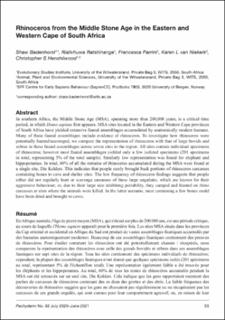| dc.contributor.author | Badenhorst, Shaw | |
| dc.contributor.author | Ratshinanga, Rialivhuwa | |
| dc.contributor.author | Parrini, Francesca | |
| dc.contributor.author | Niekerk, Karen Loise van | |
| dc.contributor.author | Henshilwood, Christopher Stuart | |
| dc.date.accessioned | 2022-04-08T13:03:18Z | |
| dc.date.available | 2022-04-08T13:03:18Z | |
| dc.date.created | 2021-09-20T16:41:00Z | |
| dc.date.issued | 2021 | |
| dc.identifier.issn | 1026-2881 | |
| dc.identifier.uri | https://hdl.handle.net/11250/2990788 | |
| dc.description.abstract | In southern Africa, the Middle Stone Age (MSA), spanning more than 200,000 years, is a critical time period, in which Homo sapiens first appears. MSA sites located in the Eastern and Western Cape provinces of South Africa have yielded extensive faunal assemblages accumulated by anatomically modern humans. Many of these faunal assemblages include evidence of rhinoceros. To investigate how rhinoceros were potentially hunted/scavenged, we compare the representation of rhinoceros with that of large bovids and zebras in these faunal assemblages across seven sites in the region. All sites contain individual specimens of rhinoceros; however most faunal assemblages yielded only a few isolated specimens (201 specimens in total, representing 5% of the total sample). Similarly low representation was found for elephant and hippopotamus. In total, 60% of all the remains of rhinoceros accumulated during the MSA were found at a single site, Die Kelders. This indicates that people rarely brought back portions of rhinoceros carcasses containing bones to cave and shelter sites. The low frequency of rhinoceros findings suggests that people either did not regularly hunt or scavenge carcasses of these large ungulates, which are known for their aggressive behaviour; or, due to their large size inhibiting portability, they camped and feasted on rhino carcasses at sites where the animals were killed. In the latter scenario, meat containing a few bones could have been dried and brought to caves. | en_US |
| dc.language.iso | eng | en_US |
| dc.relation.uri | https://pachydermjournal.org/index.php/pachyderm/article/view/288 | |
| dc.rights | Navngivelse-Ikkekommersiell 4.0 Internasjonal | * |
| dc.rights.uri | http://creativecommons.org/licenses/by-nc/4.0/deed.no | * |
| dc.title | Rhinoceros from the Middle Stone Age in the Eastern and Western Cape of South Africa | en_US |
| dc.type | Journal article | en_US |
| dc.type | Peer reviewed | en_US |
| dc.description.version | publishedVersion | en_US |
| dc.rights.holder | Copyright 2021 Pachyderm | en_US |
| cristin.ispublished | true | |
| cristin.fulltext | original | |
| cristin.qualitycode | 1 | |
| dc.identifier.cristin | 1936255 | |
| dc.source.journal | Pachyderm | en_US |
| dc.source.pagenumber | 53-62 | en_US |
| dc.relation.project | Norges forskningsråd: 262618 | en_US |
| dc.identifier.citation | Pachyderm. 2021, 62, 53-62. | en_US |
| dc.source.volume | 62 | en_US |

